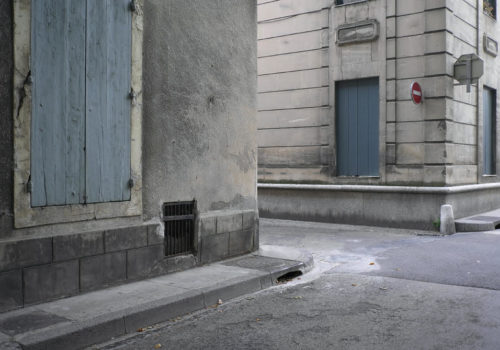Preselected by Diane Dufour while she was artistic advisor to the HSBC Photography Prize last year, Adrien Boyer exhibits his series Consonance at the Clémentine de la Féronnière Gallery which publishes a book to accompany the exhibition.
If we can add to Charles Baudelaire’s flâneur and Walter Benjamin’s ragpicker another figure of modernity capable of transfiguring the mundane, Adrien Boyer’s photographs suggest that of the street sweeper. Although absorbed in his task, the street sweeper remains receptive and gives his mind free rein to contemplate what no one else would bother noticing. Unlike the romantic flâneur inspired by the rhythm of his own footsteps, and in contrast to the ragpicker who, like a poet, gleans scraps of History, the street sweeper is a Sisyphus who earns his freedom by transforming his attentive gaze into contemplation practice.
Aimed at the foot of walls and facades, his gaze dreams up his own line of horizon. He monitors clearances and examines details. The constant reframing performed by someone who never really stops or lets his step be his guide amounts to recomposing the world. The distance between him and things, as in a face-to-face encounter, is coupled with the effect of light, and these are the two coordinates of the visible which transform the most innocuous of places into harmonious motifs. These motifs are not static; they always constitute a juncture, a relationship, a passage, or a correspondence. Faced with such visual congruities and physical openings, the viewer gets lost without the least anxiety.
Upending his social status by dint of the privilege of being the sole explorer of invisible treasures, the street sweeper walks with his mechanical gestures among the general indifference in the streets and alleys in the hours of slumber. Perceived as an outcast, he is in fact free. Like his photography predecessors, such as Charles Marville in the Paris of the Second Empire or Eugène Atget in the old Paris of the 1900s, the street sweeper goes out at the auspicious hours when streets are deserted and doors locked. In this silent theatre staged for him alone, the street sweeper takes care to skim only the day’s residue, leaving on the cobblestones, the walls, and the shutters the indelible scars of time. His endless labors lay bare these inscriptions the way a gust of wind blows sand off a buried tablets. The street sweeper is to himself the photographer’s lab, developing the negative of the day. With each passage , he recovers the patina of obsolescence: his task is a ceremony.
We walk in his footsteps with indifference. The world’s reality has been restored; the secret of its beauty is reserved for the initiated. Has Adrien Boyer thought of shedding light on some of its facets? Of following the street sweeper’s tracks and melting into his shadow so as to capture the vision of a representative of what we used to call “small trades”? The street sweeper’s gaze is as much at stake as the places he walks past: what is seen matters as much as him who saw. The photograph must capture both the state of things and the act of their contemplation. This is why you can understand Adrien Boyer’s images only if you look at them twice, for one and the same image will contain two things.
How can one tell those double presences, you might ask. You will recognize them by details which usher harmony. By training your eyes on the recesses of images of unsettling neutrality, you will discover no end of arresting elements: inscriptions, signs, materials; symbolic exchanges between forms; unlikely connections; constructions made of immaterial shadows of whole swaths of the architecture of the very image; meditative nooks; forms engendered by masked openings which nevertheless signal a line of hidden glances; or furnishings and tools abandoned in mid-task… And, while your eye is occupied by deciphering this tangle of details, you might step back a little and recover the optical consonance which is the photographer’s vision and the street sweeper’s memory.
This harmony stems from the light and the color with which the images are imbued as much as from the balance of lines and volumes. However, what might have been simply a perfect assortment is a patchwork of the world. Perfection is the art of flaws. It is the flaws that breathe life into the spaces swept by the eye. Corners come alive, a coat of grey plaster swarms with patterns, faded colors come together in a makeshift fresco: in their depths, these feckless spaces overflow with the motifs of blinds, doors, curtains, walls and partitions, carpets, screens, and banisters. While in the commonplace world everything is still shuttered, the eye of the street sweeper navigates through the labyrinth of the everyday.
Spaces and places keep disorienting the viewer. Urban lots are visions looking back at us. Their maker is the invisible. The resonance between forms and structures, the interplay of correspondences, and the minute deflections steer us back to the image: the street sweeper and the labyrinth thus become a metaphor for the photographer and the world.
Michel Poivert
Michel Poiver is Professor of Art History at the Université Paris-I Panthéon Sorbonne, art critic, and exhibition curator.
Exhibition
Adrien Boyer, Consonances
Galerie Clémentine de la Féronnière
February 2 to April 1, 2017
51, rue Saint-Louis-en-l’Ile
75004 Paris
France
www.galerieclementinedelaferonniere.fr
Publication
Adrien Boyer, Consonances
Published by the Galerie Clémentine de la Féronnière
€40
















